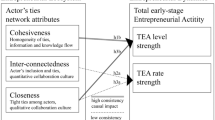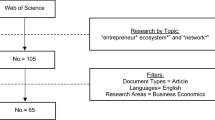Abstract
Modern conditions for the development of society include informational socio-economic relations, the system-forming role of entrepreneurship in the knowledge economy, and the need for business process performers to undertake social distancing due to the global pandemic. All these conditions actualize the need for the development of network forms for business organization, the virtualization of management systems, and improvement of the principles of their design. When designing, an important task is to select strong actors, in particular large corporations, whose potential and interests are most “useful” to the network; therefore, the purpose of this study was to determine the role of large corporations in the design of entrepreneurial innovation networks. To achieve the goal of the study, a method is proposed for assessing the entrepreneurial potential of corporations and determining their role in the projected networks. This method is based on the system and network approaches, using correlation and network analysis tools. Using the example of corporations operating in the Arctic Zone of the Russian Federation, the capabilities of the method are demonstrated. For this aim, operational data from open sources were collected, the entrepreneurial potential of a pool of the largest corporations was assessed, a network model of corporations’ potentials was visualized, and a network analysis of individual corporations as potential actors of entrepreneurial networks was presented. It is concluded that the hypothesis that all large corporations are potential effective actors for the formation of entrepreneurial alliances is not confirmed. The potential of each corporation must be assessed taking into account the specific requirements of the projected network. In the course of further research, it is planned to expand the pool of potential actors of entrepreneurial networks, develop a methodology for assessing their entrepreneurial potential, and form a methodology for selecting actors for multicomponent or multilevel models of entrepreneurial networks.
Access this chapter
Tax calculation will be finalised at checkout
Purchases are for personal use only
Similar content being viewed by others

References
Adu-Baffour, F., Daum, T., & Briner, R. (2021). Governance challenges of small-scale gold mining in Ghana: Insights from a process net-map study. Land Use Policy, 102.
Amit, R., Glosten, L., & Muller, E. (1993). Challenges to theory development in entrepreneurship research. Journal of Management Studies. Wiley Online Library, 30, 815–834.
Aparicioa, S., Urbanoc, D., & Stenholmd, P. (2021). Attracting the entrepreneurial potential: A multilevel institutional approach. Technological Forecasting and Social Change, 168, 1–13.
Asaul, A., Skumatov, E., & Lokteeva, G. (2004). Methodological aspects of the formation and development of entrepreneurial networks. Humanism. (In Russian).
Asaul, A., Vladimirskij, E., & Gordeev, D. (2008). Patterns and trends in the development of modern entrepreneurship. ANO IPEV. (In Russian).
Barney, J. (1991). Firm resources and sustained competitive advantage. Journal of Management, 17(1), 99–120.
Bull, I., & Willard, G. (1993). Towards a theory of entrepreneurship. Journal of Business Venturing, 8, 183–195.
Burt, R. (1980). Models of network structure. Annual Review of Sociology, 6, 79–141.
Cabello-Medina, C., Carmona-Lavado, A., & Cuevas-Rodrigues, G. (2019). Contingency view of alliance management capabilities for innovation in the biotech industry. Business Research Quarterly, 118, 1–17.
Cehan, A., Eva, M., & Iatu, C. (2021). A multilayer network approach to tourism collaboration. Journal of Hospitality and Tourism Management, 46, 316–326.
Cenamor, J., Parida, V., & Wincent, J. (2019). How entrepreneurial SMEs compete through digital platforms: The roles of digital platform capability, network capability and ambidexterity. Journal of Business Research, 100, 196–206.
De Vaana, M., & Wang, D. (2020). Micro-structural foundations of network inequality: Evidence from a Feld experiment in professional networking. Social Networks, 63, 213–230.
Dubrovskij, V. (2004). The economic nature of the corporation. Bulletin of the Ural State University of Economics, 8, 10–23. (In Russian).
Etriya, E., Scholten, V., Wubben, E., & Omta, O. (2019). The impact of networks on the innovative and financial performance of more entrepreneurial versus less entrepreneurial farmers in West Java, Indonesia. Wageningen Journal of Life Sciences, 89, 1–14.
Fierro, L., Cano, R., & Garcia, G. (2020). Modelling of a multi-agent supply chain management system using colored petri nets. Procedia Manufacturing, 42, 288–295.
Filips, D., & Garsia-Dias, A. (1984). Network analysis techniques. Mir. (In Russian).
Freeman, R. (2001). A stakeholder theory of the modern corporation. Perspectives in Business Ethics Sie, 3, 144. Retrieved from: https://academic.udayton.edu
Freeman, J., & Engel, J. S. (2007). Models of innovation: Startups and mature corporations. California Management Review, 1, 94–119.
Galbraith, D. (1979). Economic theories and goals of society. Progress. (In Russian).
Guseva, G. (2019). To the question of the peculiarities of the types of venture strategies of the corporation. Eurasian Union of Scientists, 4(61), 4–6. (In Russian).
Harris, J. (2021). Bridging the gap between ‘fin’ and ‘tech’: The role of accelerator networks in emerging FinTech entrepreneurial ecosystems. Geoforum, 122, 174–182.
Hernandez-Carrion, C., Camarero-Izquierdo, C., & Gutierrez-Cillan, J. (2019). The internal mechanisms of entrepreneur’s socialcapital: A multi-network analysis. Business Research Quarterly, 116, 1–18.
Hofer, A., Schnella, J., Becka, B., & Reinharta, G. (2019). Potential-based technology planning for production companies. Procedia CIRP, 81, 1400–1405.
Holmberg, S., & Cummings, J. (2009). Building successful strategic alliances. Strategic process and analytical tool for selecting partner industries and firms. Long Range Planning, 42(2), 164–193.
Jarrahi, M., & Sawyer, S. (2019). Networks of innovation: The sociotechnical assemblage of tabletop computing. Research Policy: X, 1.
Kastels, M. (2000). Information age: Economy, society and culture. GU VShE. (In Russian).
Kenis, P., & Raab, J. (2020). Back to the future: Using organization design theory for effective organizational networks. Perspectives on Public Management and Governance, 3(2), 109–123.
Ketova, N., & Ovchinnikov, V. (2015). The role of large corporations in the formation of the region’s innovation system. Bulletin of the Adyghe State University, 4(170), 96–103. (In Russian).
Kohtamäki, M., Parida, V., Oghazi, P., Gebauer, H., & Baines, T. (2019). Digital servitization business models in ecosystems: A theory of the firm. Journal of Business Research, 104, 380–392.
Krueger, J., & Brazeal, D. (1994). Entrepreneurial Potential and Potential Entrepreneurs. Entrepreneurship Theory and Practice, 4, 91–104.
Larraneta, B., Molina-Morales, F., & Herrero, I. (2019). Centrality in networks of geographically proximate firms and competitive capabilities. Business Research Quarterly, 129, 1–14.
Marchiori, D., & Francj, M. (2020). Knowledge transfer in the context of inter-organizational networks: Foundations and intellectual structures. Journal of Innovation & Knowledge, 5, 130–139.
Meteleva, M. (2019). Net forms a public administration of the macroregion Russian Arctic: Current state and directions of development. North and Market: Formation of the Economic Order, 3(65), 4–18. (In Russian).
Meteleva, M. (2020a). The role of entrepreneurship in the information paradigm of economic development and some approaches to the design of entrepreneurial networks. MIRBIS Bulletin, 3(23), 49–62. (In Russian).
Meteleva, M. (2020b). Designing entrepreneurial networks: Assessment of the network potential of the region of the Arctic zone of the Russian Federation. North and Market: Formation of the Economic Order, 3(69), 56–71. (In Russian).
Newman, M. (2003). The structure and function of complex networks. Society for Industrial and Applied Mathematics, 2, 167–256.
O’Connor, N., Lowry, P., & Treiblmaier, H. (2020). Interorganizational cooperation and supplier performance in high-technology supply chains. Heliyon, 6(3), e03434.
Pilyasov, A., & Bogodukhov, A. (2021). Arctic corporation: Approaches to the formation of a new theory (part 1). ECO, 1, 40–66. (In Russian).
Popadyuk, T. (2020). Intra-corporate entrepreneurship and development of innovative activity. Innovative Development of the Economy, 1(55), 72–76. (In Russian).
Rijnsoever, F., & Eveleens, Ch. (2021). Money don’t matter? How incubation experience affects start-up entrepreneurs’ resource valuation. Technovation, 106.
Sheresheva, M. (2010). Forms of company networking. GU-VShE. (In Russian).
Smolander, K., Rossi, M., & Pekkola, S. (2021). Heroes, contracts, cooperation, and processes: Changes in collaboration in a large Enterprise systems project. Information & Management, 58.
Stout, L. (2005). On the nature of corporations. Cornell Law Faculty Publications Paper, 1, 252–268.
Thompson, J. (2004). The facets of the entrepreneur: Identifying entrepreneurial potential. Management Decision, 2, 243–258.
Tkachenko, I. (2018). Taking into account the interests of stakeholders in the modern paradigm of corporate governance. Management Sciences in the Modern World, 1, 205–209. (In Russian).
Tkachenko, I. (2019). Stakeholder value assessment: Evolution of the methodological approach and applied models. In Actual problems of corporate governance and business development: Materials of the international scientific and practical conference. Ural State University of Economics. (In Russian).
Tkachenko, I., & Starikov, E. (2008). Model of the integrated potential assessment of the industrial complex of the region. Bulletin of the Irkutsk State Economic Academy, 2, 45–48. (In Russian).
Travica, B. (1997). The design of the virtual organization: A research model. Americas conference on information systems. Proceedings 270. Retrieved from: http://aisel.aisnet.org/amcis1997/270
Waltersmanna, L., Kiemela, S., Bogdanova, I., Lettgena, J., Miehea, R., Sauera, A., & Mandela, J. (2019). Benchmarking holistic optimization potentials in the manufacturing industry – A concept to derive specific sustainability recommendations for companies. Procedia Manufacturing, 39, 685–694.
Author information
Authors and Affiliations
Corresponding author
Editor information
Editors and Affiliations
Rights and permissions
Copyright information
© 2022 The Author(s), under exclusive licence to Springer Nature Singapore Pte Ltd.
About this entry
Cite this entry
Tkachenko, I.N., Meteleva, M.A. (2022). Virtual Entrepreneurial Networks in the Russian Arctic. In: Pak, E.V., Krivtsov, A.I., Zagrebelnaya, N.S. (eds) The Handbook of the Arctic. Palgrave Macmillan, Singapore. https://doi.org/10.1007/978-981-16-9250-5_59-1
Download citation
DOI: https://doi.org/10.1007/978-981-16-9250-5_59-1
Received:
Accepted:
Published:
Publisher Name: Palgrave Macmillan, Singapore
Print ISBN: 978-981-16-9249-9
Online ISBN: 978-981-16-9250-5
eBook Packages: Social SciencesReference Module Humanities and Social SciencesReference Module Business, Economics and Social Sciences



